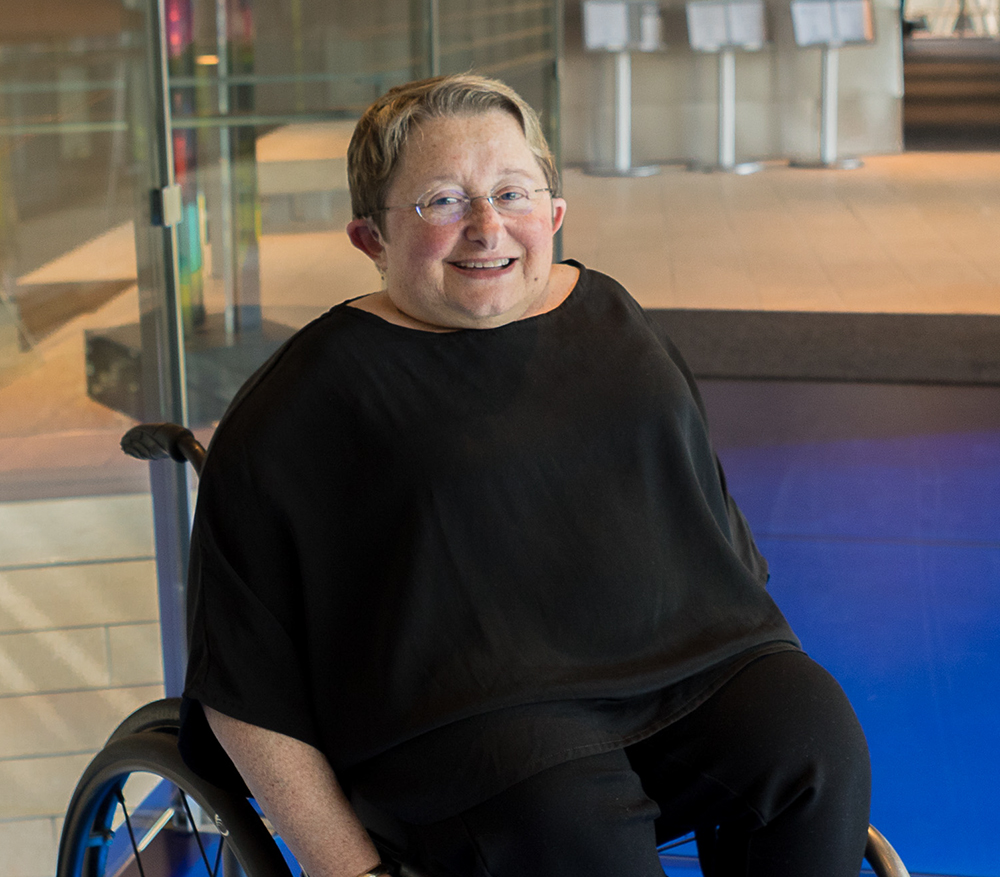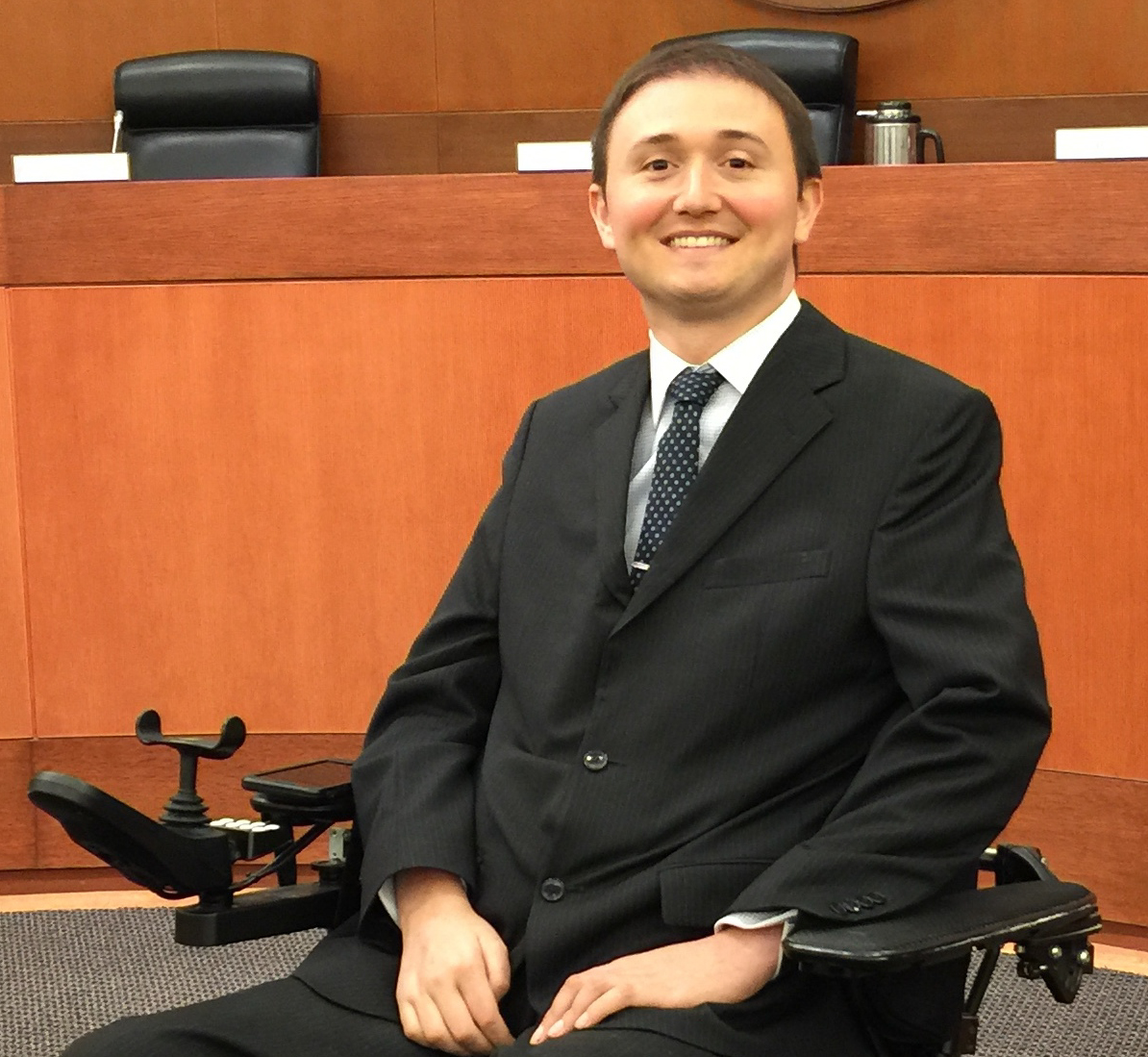Interview with Karen Braitmayer by Seth McBride

Architect Karen Braitmayer has worked for 30 years to help design forward-thinking buildings of all types and served as the chairperson for the U.S. Access Board, the federal authority on accessibility code. The American Institute of Architects awarded her the 2019 Whitney M. Young Jr. Award for social responsibility.
NEW MOBILITY: Access to accessible housing is one of the biggest issues that we hear about. In many cities, there are accessible apartments and condos available, but only if you can afford thousands of dollars in rent and mortgage. Units that are accessible but also affordable are rare. Where do you see opportunities for increasing the supply of affordable, accessible housing?
Karen Braitmayer: I think everybody’s being challenged about affordable housing. I don’t think it’s just people with disabilities that are having trouble finding affordable housing. I live in a city [Seattle] that is distinctly not affordable. Everything is ridiculous. My daughter is embarking on a career as a school teacher, and I don’t know how she’s going to live, buy a house or even a modest condo in our community. But the issue of how to increase access to accessible housing in any affordability range is also a major barrier to independent lives for people with disabilities.
In my state, 5% of all multifamily housing is being built with accessible features. And I know that for every project that we consult on, those units really are accessible. The big challenge is that there’s no mechanism or program in our community to match or to hold back those units until someone who has a mobility need can apply for them. They go on the market just like every other unit, and they are sold or leased to the first comer. And that means when someone who needs those mobility-friendly features goes to look for an accessible unit, we have a very limited stock of open units to choose. This has nothing to do with price.
There has to be some connection between those units that developers and contractors and architects are working so hard to make wheelchair-friendly and getting them to the people who need them. There’s an opportunity for an organization, an agency or a coalition to find a way to match those units to those individuals who need them.
NM: You’ve worked both in architecture and the public policy arena, and it sounds like you see the issue of increasing access to accessible housing as more of a policy challenge than a design challenge, is that right?
KB: There is opportunity, whether it’s through the private sector, or through the public sector, to further this benefit of building codes that require up to 5% to be accessible housing. It’s great that we require those to be built, but we haven’t gone far enough to identify how those units can be matched to the individuals that need them. And that, I think, is the missing link.
NM: Another big challenge with accessible housing is if you have a family. Typically, in multi-unit housing, accessible units are one bedroom or a studio. But an accessible unit that could support a full family is much harder to find.
KB: How does a family fit in to our city when the developers are building only units that are designed to be shared by, maybe, two people? That’s also a huge question for everybody, not just for people with disabilities. The big challenge for people with disabilities is that the federal and state accessibility requirements address only multifamily dwellings. Home builders aren’t building new single-family houses that are fully accessible so they’re not on the market.
But we do have a cool new thing that is available here in the Pacific Northwest. There’s a realty listing service called the Northwest Multiple Listings Service, and they have just taken on adding a very extensive list of wheelchair-friendly, or accessible-friendly features so sellers can list specifics like a no-step entrance or wide doors. I think that is going to make it much easier for people to find homes that have those good bones. They may not be ADA compliant, but they may be close for your needs, so it would be easy to make some modest architectural changes and make it work for you. I’m super excited about this and expect it to be a huge benefit here. I’m hoping that this becomes popular enough that it gets rolled out across the country.
NM: Do you think some of the push for that has come with the aging of the baby boomer generation, and how many more people are going to need accessibility features?
KB: Oh, absolutely. I think people are increasingly aware. I have more residential architects getting in touch with me saying that when people renovate their homes, they want to include these features because they are seeing how important it is for their parents, and how they’d like to have them in their own homes for the long term. Every time we can help people modify their home for aging, now we’ve got another house on the market that is usable by people of all abilities. If we can continue to increase the public’s desire for this, then maybe by people demanding it, we’ll see home builders consider adding those features right off the bat, and we can increase our accessible housing market. Home developers build what people buy.
NM: It’s so interesting because for a long time, there was a certain stigma associated with accessibility features — like real estate agents wouldn’t want to list a house’s accessibility features because they thought it would turn off buyers who didn’t think they needed them.
KB: I think that there are different ways that you can identify accessibility features. For example, I have a no-step roll-in shower in my bathroom. If that shower is called a roll-in shower, you think about it one way. You call it a European, no-step spa shower, now all of a sudden people think that that’s a cool thing to have, right?
The Cerebral Palsy Foundation has a new campaign called Accessibility is Beautiful, where it’s trying to encourage acceptance of accessibility features in private homes by highlighting beautiful examples. In my work, homes where we modified the house specifically for an individual or a family with disability, every single one of them is creative and interesting and beautiful. Architects need to step up to the plate and realize that you can do a beautiful job of making things accessible. It’s just a design challenge. It doesn’t have to look like a hospital bathroom.
NM: Moving away from residential to the commercial side of your work — you’ve done projects for some of the biggest companies in the world, from Amazon to Microsoft to Nike. Do you think companies are slowly starting to think about accessibility in a way that goes beyond minimum code requirements?
KB: Absolutely. I have a number of clients, spearheaded by the tech sector, that are trying very hard to develop buildings and facilities and company policies that are most welcoming to people with disabilities. It’s exciting because in our current political climate, where the government is restricted from developing new regulations, we really have to look outside the governmental sector to find opportunities to do better. I’m thrilled that parts of the corporate sector are taking the lead. And it’s really because they want to be better in the marketplace. If a company wants to be more productive, making the best products, selling the most, they need the best employees to be effective. They recognize that there’s competition for really good staff, and they want to be sure that they’re getting the best people. And the best people include people with disabilities. Just like these companies making sure that you have access to meals anytime, nap rooms, game areas and all the desirable employee benefits, they want to be sure that everyone feels welcome and supported on their campuses. So it’s a market-driven decision, even though it’s a social justice decision as well.

Designed by House + House Architects to incorporate universal design principles, this dream home owned by Pat Wright and Deb Zeyen is showcased as part of the Cerebral Palsy Foundation’s Accessibility is Beautiful initiative. Learn more at yourcpf.org/casacabopulmo
by Josh Basile

Josh Basile is a trial attorney in Maryland and Washington, D.C., and is passionate about all things SCI-related. After a C4-5 injury, he founded Determined2Heal and co-founded SPINALpedia.com. He is a board member of United Spinal Association and a tireless advocate for Medicaid reform.
Medicaid’s strict rules create barriers to earnings and employment for workers with disabilities, and it’s time for advocates to work with their national and state elected officials to dial these rules back. It’s time to create new national programs to change the disability employment landscape across the country.
If a person has a significant disability and requires community-based healthcare, their ability to work often comes down to what Medicaid programs are available in their state. They can’t turn to private insurance because there is no long-term care plan available once a person acquires a disability. Without Medicaid, all long-term care expenses come out-of-pocket, which is not financially feasible for most.
Although buy-in programs, which allow eligible workers with disabilities to gain and maintain Medicaid have existed for over two decades, most states have implemented overly-strict rules on enrollee’s earnings and savings. There was little to no data available to assess possible fiscal impact of these programs on state budgets, and the states feared the programs would lead to higher costs and expanded enrollment. These fears never came to fruition.
Making major changes to these programs on both the state and national levels will chip away at the long-persisting barriers that contribute to degradingly high unemployment and underemployment. People with disabilities who desire to work should always be encouraged to do so. No person with a significant disability should ever be forced to choose between vital healthcare and working.
Reforms at the State Level
We should advocate for these six state-level improvements to Medicaid buy-ins:
1. Remove income limits
2. Remove asset limits
3. Remove upper age limit
4. Remove spousal inclusion from financial eligibility
5. Implement a sliding scale premium payment structure
6. Allow assets earned while enrolled in the buy-in to not be counted in financial eligibility for other Medicaid assistance programs after leaving the buy-in.
States typically operate their Medicaid buy-in programs using the 1997 Balanced Budget Act or the 1999 Ticket to Work and Work Incentives Improvement Act. Nothing prevents states from simultaneously using both the BBA and TWWIIA at the same time. Utilizing both would provide more flexibility and options when implementing the above-mentioned recommendations for multiple targeted populations.
Massachusetts and Washington provide examples of what creative thinking can achieve. By using the BBA and TWWIIA simultaneously and a federal waiver allowing them to experiment, Massachusetts is able to define work hour requirements and allow for grace periods to promote earnings and employment for diverse disability populations, including those with cyclical conditions. In April 2019, the governor in Washington state signed legislation that removes previous income, asset and higher age limits for workers with disabilities enrolled in their Medicaid buy-in.
Reforms at the National Level
Having to cross state lines for a new job is a major barrier for workers with significant disabilities. Medicaid buy-in enrollment is state-specific and not portable, meaning you can’t freely transition from state to state without reapplying. Therefore, our community’s skills and talents are not steered by the marketplace, and instead many remain stuck within a specific state in order to maintain long-term services and supports. If a person receives a job in another state, upon moving they lose their current LTSS and then must reapply for all new LTSS in the new state with no guarantee of enrollment. This is a scary road that most never travel down.
Congress could fix this barrier through legislation to create a national buy-in for LTSS-only services. Enrollees would be workers with significant disabilities who have substantial LTSS needs and expenses — such as specialized durable medical equipment, nursing and personal assistance services. To qualify, these enrollees must have LTSS costs greater than 25% of their annual salary. For instance, if a person makes $40,000 annually, then their LTSS costs must be greater than $10,000 to qualify. This will strategically target workers with substantial long-term care needs.
Congress also needs to introduce legislation to support our nation’s largest employer — the federal government. Federal employees with disabilities have a difficult time maintaining Medicaid eligibility and advancing within the government. Many workers remain stuck in lower-level positions because of income requirements within their state-level Medicaid buy-in. Lower level positions result in less earnings and fewer leadership roles, which essentially prevents the disability community from having their voices at the table to affect major decision making.
Creating a federal employee buy-in program that adopts all of the state level improvements mentioned above would drastically incentivize the disability community to work for the federal government. In 2018, the U.S. federal government employed 2.8 million workers. This program could provide a buy-in option even if a particular state does not have a great Medicaid buy-in.
If Congress were to pass both a LTSS-only buy-in and a federal employee buy-in, then the national landscape for workers with disabilities would be transformed forever.
** This post was originally published on http://www.newmobility.com/2019/09/big-ideas-in-community/

